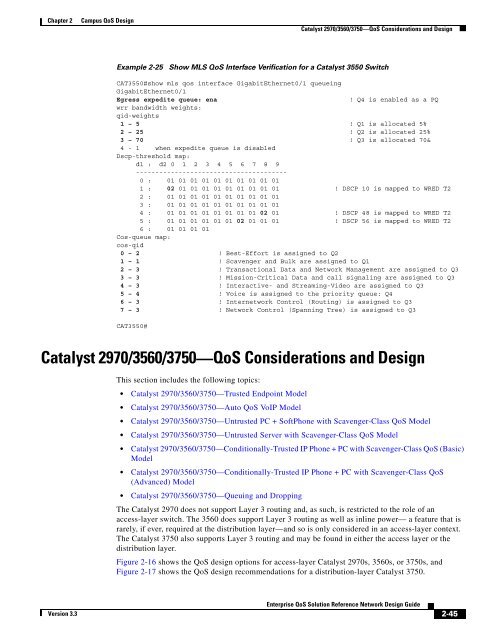Enterprise QoS Solution Reference Network Design Guide
Enterprise QoS Solution Reference Network Design Guide
Enterprise QoS Solution Reference Network Design Guide
You also want an ePaper? Increase the reach of your titles
YUMPU automatically turns print PDFs into web optimized ePapers that Google loves.
Chapter 2 Campus <strong>QoS</strong> <strong>Design</strong><br />
Version 3.3<br />
Catalyst 2970/3560/3750—<strong>QoS</strong> Considerations and <strong>Design</strong><br />
Example 2-25 Show MLS <strong>QoS</strong> Interface Verification for a Catalyst 3550 Switch<br />
CAT3550#show mls qos interface GigabitEthernet0/1 queueing<br />
GigabitEthernet0/1<br />
Egress expedite queue: ena ! Q4 is enabled as a PQ<br />
wrr bandwidth weights:<br />
qid-weights<br />
1 – 5 ! Q1 is allocated 5%<br />
2 – 25 ! Q2 is allocated 25%<br />
3 – 70 ! Q3 is allocated 70&<br />
4 - 1 when expedite queue is disabled<br />
Dscp-threshold map:<br />
d1 : d2 0 1 2 3 4 5 6 7 8 9<br />
---------------------------------------<br />
0 : 01 01 01 01 01 01 01 01 01 01<br />
1 : 02 01 01 01 01 01 01 01 01 01 ! DSCP 10 is mapped to WRED T2<br />
2 : 01 01 01 01 01 01 01 01 01 01<br />
3 : 01 01 01 01 01 01 01 01 01 01<br />
4 : 01 01 01 01 01 01 01 01 02 01 ! DSCP 48 is mapped to WRED T2<br />
5 : 01 01 01 01 01 01 02 01 01 01 ! DSCP 56 is mapped to WRED T2<br />
6 : 01 01 01 01<br />
Cos-queue map:<br />
cos-qid<br />
0 – 2 ! Best-Effort is assigned to Q2<br />
1 – 1 ! Scavenger and Bulk are assigned to Q1<br />
2 – 3 ! Transactional Data and <strong>Network</strong> Management are assigned to Q3<br />
3 – 3 ! Mission-Critical Data and call signaling are assigned to Q3<br />
4 – 3 ! Interactive- and Streaming-Video are assigned to Q3<br />
5 – 4 ! Voice is assigned to the priority queue: Q4<br />
6 – 3 ! Internetwork Control (Routing) is assigned to Q3<br />
7 – 3 ! <strong>Network</strong> Control (Spanning Tree) is assigned to Q3<br />
CAT3550#<br />
Catalyst 2970/3560/3750—<strong>QoS</strong> Considerations and <strong>Design</strong><br />
This section includes the following topics:<br />
Catalyst 2970/3560/3750—Trusted Endpoint Model<br />
Catalyst 2970/3560/3750—Auto <strong>QoS</strong> VoIP Model<br />
Catalyst 2970/3560/3750—Untrusted PC + SoftPhone with Scavenger-Class <strong>QoS</strong> Model<br />
Catalyst 2970/3560/3750—Untrusted Server with Scavenger-Class <strong>QoS</strong> Model<br />
Catalyst 2970/3560/3750—Conditionally-Trusted IP Phone + PC with Scavenger-Class <strong>QoS</strong> (Basic)<br />
Model<br />
Catalyst 2970/3560/3750—Conditionally-Trusted IP Phone + PC with Scavenger-Class <strong>QoS</strong><br />
(Advanced) Model<br />
Catalyst 2970/3560/3750—Queuing and Dropping<br />
The Catalyst 2970 does not support Layer 3 routing and, as such, is restricted to the role of an<br />
access-layer switch. The 3560 does support Layer 3 routing as well as inline power— a feature that is<br />
rarely, if ever, required at the distribution layer—and so is only considered in an access-layer context.<br />
The Catalyst 3750 also supports Layer 3 routing and may be found in either the access layer or the<br />
distribution layer.<br />
Figure 2-16 shows the <strong>QoS</strong> design options for access-layer Catalyst 2970s, 3560s, or 3750s, and<br />
Figure 2-17 shows the <strong>QoS</strong> design recommendations for a distribution-layer Catalyst 3750.<br />
<strong>Enterprise</strong> <strong>QoS</strong> <strong>Solution</strong> <strong>Reference</strong> <strong>Network</strong> <strong>Design</strong> <strong>Guide</strong><br />
2-45
















